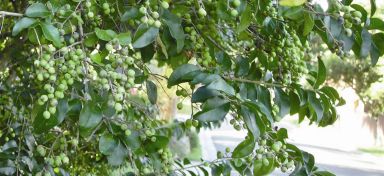
There are two types of privet, small-leaf and large-leaf Privet. Both are aggressive bushland invaders, pests in gardens and can trigger serious allergic reactions. Growing between 4 - 8m high, both produce strongly scented flowers in spring/summer which are followed by berries.
Origin: Eastern Asia, Europe and North Africa
Habit: multi stemmed evergreen shrub or small tree to a height of 2–10 m
Broad-leaf: Oval Leaves generally 50–130 mm long; cream flower tube shorter or as long as the lobes; anthers well extended from the tubes; fruits bluish-black, on short stalks.
Small-leaf: Oval-shaped leaves occur in opposite pairs and are 1–7 cm long, leaf margins smooth to wavy; cream flower tube shorter than lobes; anthers mauve to purple, fruits blackish-purple, on hairy stalks.
European: Narrow hairless leaves 2-6cm; leaf margins never wavy; cream flower tube slightly longer than lobes; anthers white and barely extended from the tubes; fruits glossy black, on short, slightly hairy stalks.
Dispersal: seeds are commonly spread by fruit-eating birds
General Biosecurity Duty
All plants are regulated with a general biosecurity duty to prevent, eliminate or minimise any biosecurity risk they may pose. Any person who deals with any plant, who knows (or ought to know) of any biosecurity risk, has a duty to ensure the risk is prevented, eliminated or minimised, so far as is reasonably practicable.
Control
Small to medium-sized privet plants can be dug out by hand and placed upside-down to dry out the roots. Wear gloves and protective clothing.
